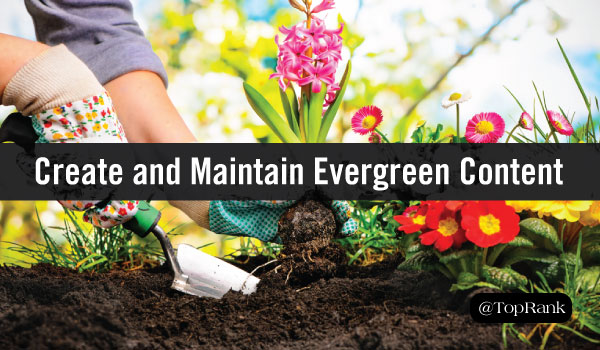Every good gardener knows there are two types of flowering plants: Annuals and perennials. Annuals bloom once and have to be replanted the next growing season. Perennials stick around; they continue to flower year after year.
Most blog posts are annuals. You publish them, they generate views and shares for a while, and then they basically go dormant. Readers might happen across them occasionally. But think of it this way: When was the last time you went through your favorite blog’s archives? Or clicked on a search result that was over a year old?
Rarely, though, you will find that a post has perennial appeal—what some marketers call “evergreen content.” Even though you published it in 2012, it still gets liked and shared. That’s a clear sign the content is still relevant to your audience.
Evergreen content continues to provide value without extra effort, and it can support spin-offs that fill in blanks in your editorial calendar. So it makes sense to invest some time in creating and caring for your perennials.
How to Create Evergreen Content
On one level, what content becomes evergreen is up to your audience. There will always be a blog post or two that get a surprising amount of sustained attention—posts that just happen to meet an ongoing need.
We’ll talk about how to make the most of these accidental perennials a little later. For now, though, know that it is possible to design content to have lasting value. Aim for content that is:
- Fundamental and Timeless. Think “how to” content, frequently asked questions, guides to a subject that stays consistent over time. The opposite of newsjacking posts or posts about cutting-edge trends.
- Take a comprehensive look at a single topic. Go deep, with links to content that explores topics of parallel interest. That kind of value is exactly what will continue to bring in readers over time.
- “Best Answer” Content. Make sure your topic is highly relevant to your audience—fundamental, timeless, substantial content that doesn’t answer someone’s burning question won’t become evergreen.
- Highly Visible. Your blog may not be the best spot for content that’s evergreen by design. Let your accidental evergreens live there, but consider a more permanent home for your new perennials. For example, this comprehensive guide to advertising on LinkedIn has its own page on the root directory.
How to Identify Accidental Evergreens
A quick look through your site’s Google Analytics should show what content is still generating interest. Look at your traffic report to see what your top-performing posts have been in the past six months—older posts that are still in the top ten are definitely worth your attention.
It’s worth exploring what keywords your site is ranking for, too. You will likely find some unexpected rankings—blog posts that continue to bring in traffic for a specific long tail keyword. These posts hold some hidden value and are worth maintaining.
Care and Maintenance of Evergreen Content
Now that you have identified the perennials in your garden—and perhaps planted a few new ones—you can help them grow even more value:
- Refresh Older Posts. If an outdated post is still pulling in traffic, it’s worth pulling in fresh statistics and a few new visuals to make it even more relevant. Don’t forget to change the date and note that it was edited, so readers will know it’s au courant.
- Make a Hub. Your evergreen post can become the center of an SEO-friendly little content empire. Create new content to expand on part of the post, or address a relevant side topic. Then crosslink between the old and new.
- Expand and Feature. Take a shorter piece that still gets traffic and expand it—turn your quick how-to into a more in-depth guide. Include visual interest, relevant statistics, and links to other resources (we call this a “power page”). Then take your new asset and give it pride of place, on its own page rather than in your blog.
- Create a Gated Asset. Evergreen content’s popularity is your audience telling you what they want to know more about. Create an eBook or white paper that further explores the topic of your evergreen content. Then add a CTA to the original post that links to your new asset.
- Start a Series. As soon as a movie hits big at the box office, suddenly it becomes “part one of a trilogy.” Take the same approach with a surprise evergreen hit. Make it the first in a series of posts on the topic, and link them together.
- Find New Formats. You can repurpose evergreen content to attract an even wider audience. Make it the basis of a webinar. Turn the stats into an infographic. Discuss it on a podcast. All of these can build on the audience’s demonstrated interest in the topic.
How Green Is Your Thumb?
Evergreen content is a bonus for content marketers. Not only does it generate traffic without effort, it can serve as a starting point to drive even more value for your audience. It’s worth checking for perennials already growing in your content garden, and planting some for next season, too.
How do you repurpose evergreen content? Let me know in the comments.
Gain a competitive advantage by subscribing to the
TopRank® Online Marketing Newsletter.
© Online Marketing Blog - TopRank®, 2017. | How Does Your Garden Grow? How to Create and Maintain Evergreen Content | http://www.toprankblog.com
The post How Does Your Garden Grow? How to Create and Maintain Evergreen Content appeared first on Online Marketing Blog - TopRank®.

No comments:
Post a Comment